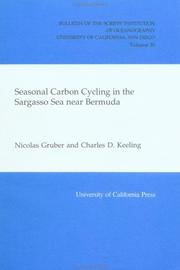| Listing 1 - 3 of 3 |
Sort by
|

ISBN: 1282355805 9786612355806 0520915968 9780520915961 9781282355804 0520098331 9780520098336 6612355808 Year: 1999 Publisher: Berkeley University of California Press
Abstract | Keywords | Export | Availability | Bookmark
 Loading...
Loading...Choose an application
- Reference Manager
- EndNote
- RefWorks (Direct export to RefWorks)
Each year, the concentration of dissolved inorganic carbon (DIC) in the mixed layer at Station S in the Sargasso Sea decreases from winter to summer by about 30 umol/kg. The authors of this study demonstrate that by simultaneously observing changes in the stable isotopic ration of DIC, it is possible to quantify the contribution of physical and biological processes to this summer-fall drawdown. They find that biology is the dominant contrbutor to the drawdown, but that physical processes also play an important role.
Seawater --- Carbon --- Carbon cycle (Biogeochemistry) --- Analysis. --- air sea boundary layer. --- air sea exchange. --- bermuda. --- biogeochemistry. --- carbon balance. --- carbon cycle. --- carbon. --- conservation. --- dic. --- ecosystem. --- environment. --- environmentalism. --- healthy oceans. --- inorganic carbon. --- island. --- marine environments. --- natural science. --- nature. --- nonfiction. --- ocean. --- oceanography. --- pollution. --- sargasso sea. --- science. --- sea. --- seawater. --- sediment traps. --- surface oceans. --- tropics. --- upper ocean. --- water health.
Book
ISBN: 9780691017075 0691017077 Year: 2006 Publisher: Princeton (N.J.): Princeton university press,
Abstract | Keywords | Export | Availability | Bookmark
 Loading...
Loading...Choose an application
- Reference Manager
- EndNote
- RefWorks (Direct export to RefWorks)
'Ocean Biogeochemical Dynamics' provides a broad theoretical framework upon which graduate students and upper-level undergraduates can formulate an understanding of the processes that control the mean concentration and distribution of biologically utilized elements and compounds in the ocean. Though it is written as a textbook, it will also be of interest to more advanced scientists as a wide-ranging synthesis of our present understanding of ocean biogeochemical processes. The first two chapters of the book provide an introductory overview of biogeochemical and physical oceanography. The next four chapters concentrate on processes at the air-sea interface, the production of organic matter in the upper ocean, the remineralization of organic matter in the water column, and the processing of organic matter in the sediments. The focus of these chapters is on analyzing the cycles of organic carbon, oxygen, and nutrients. The next three chapters round out the authors' coverage of ocean biogeochemical cycles with discussions of silica, dissolved inorganic carbon and alkalinity, and CaCO3. The final chapter discusses applications of ocean biogeochemistry to our understanding of the role of the ocean carbon cycle in interannual to decadal variability, paleoclimatology, and the anthropogenic carbon budget. The problem sets included at the end of each chapter encourage students to ask critical questions in this exciting new field. While much of the approach is mathematical, the math is at a level that should be accessible to students with a year or two of college level mathematics and/or physics.
Chemical oceanography --- Biogeochemistry --- Océanographie chimique --- Biogéochimie --- Mathematical models --- Biogeochemistry. --- Chemical oceanography. --- Mathematical models. --- Océanographie chimique --- Biogéochimie --- Marine chemistry --- Océanographie chimique. --- Biogéochimie. --- Modèles mathématiques --- Modèles mathématiques. --- Oceanography --- Water chemistry --- Biochemistry --- Geochemistry --- Chemical oceanography - Mathematical models --- Biogeochemistry - Mathematical models --- Océanographie chimique. --- Biogéochimie. --- Modèles mathématiques.

ISBN: 0520098331 Year: 1999 Volume: 30 Publisher: Berkeley ; Los Angeles ; Oxford University of California Press
Abstract | Keywords | Export | Availability | Bookmark
 Loading...
Loading...Choose an application
- Reference Manager
- EndNote
- RefWorks (Direct export to RefWorks)
Carbon cycle (Biogeochemistry) --- Carbone--Cycle --- Cycle du carbone (Biogéochimie) --- Koolstof--Cyclus --- Koolstof-stikstofcyclus (Biogeochemie) --- Koolstofcyclus (Biogeochemie) --- Seawater --- Analysis --- Carbon
| Listing 1 - 3 of 3 |
Sort by
|

 Search
Search Feedback
Feedback About UniCat
About UniCat  Help
Help News
News